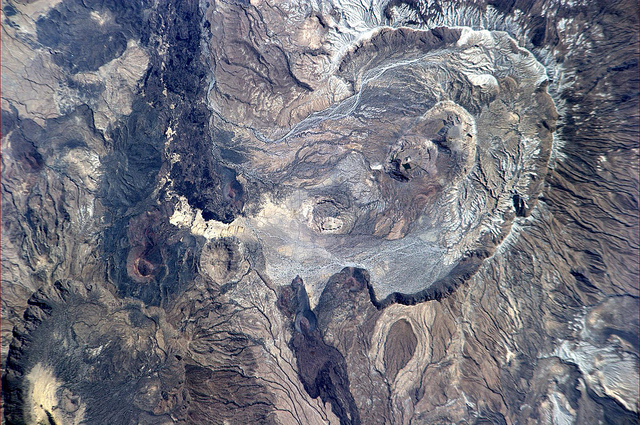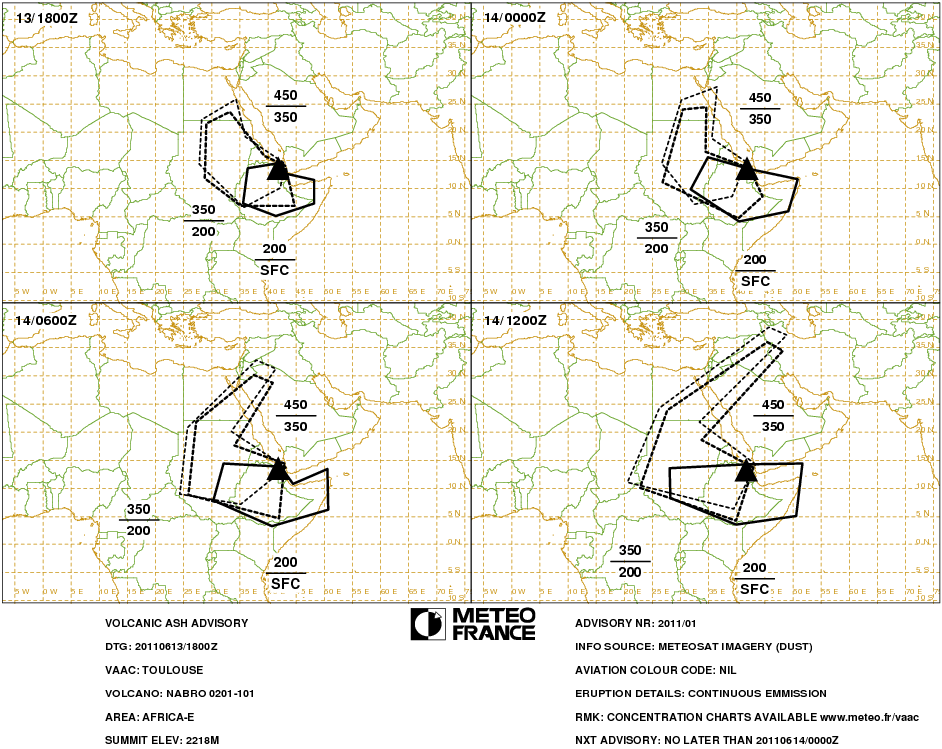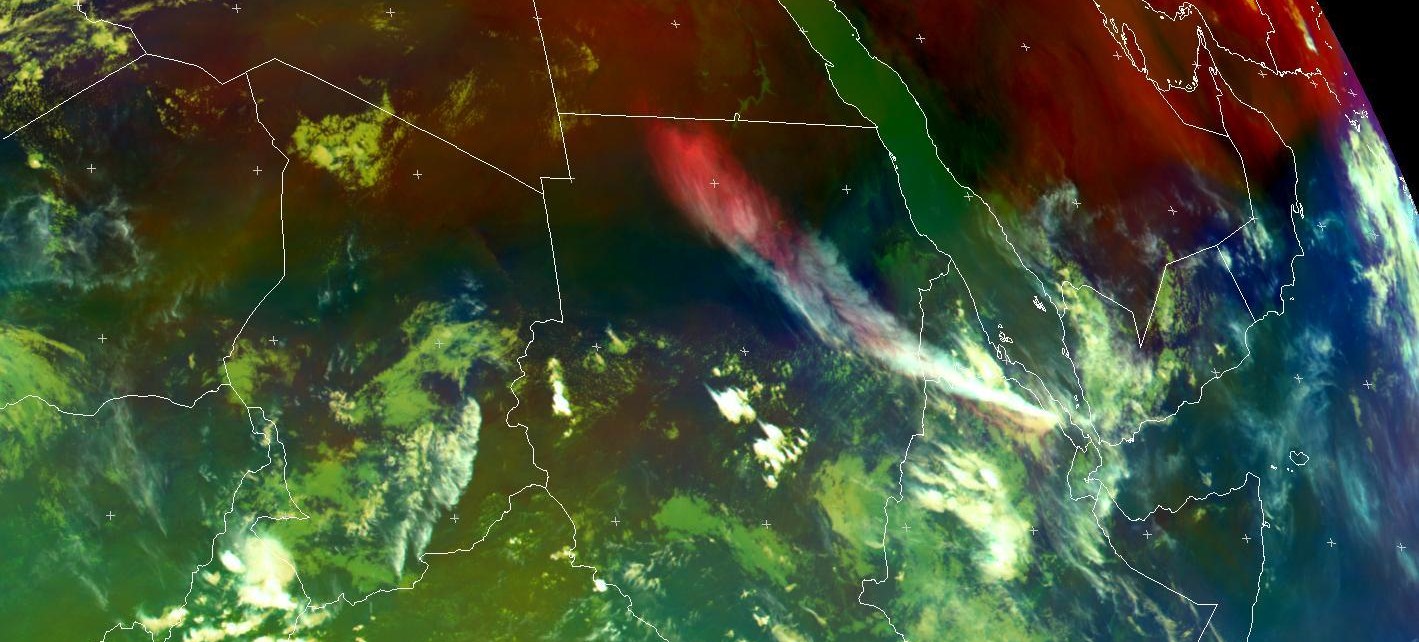
© ESA/NASANabro volcano, Eritrea, next to the border with Ethiopia.
The Anabro (Nabro) volcano in the Northern Red Sea Region of Eritrea has erupted sending an ash plume more than 13.5 kilometres into the sky and disrupting air traffic across eastern Africa.
Part of the Afar Triangle, the stratovolcano is one of many volcanic caldera complexes in the north easternmost part of the East African Rift valley region. Nabro is located in the Danakil Depression, close to Eritrea's border with Ethiopia and north of Djibouti, and has not erupted in at least 150 years. It is the most prominent of 3 large volcanoes (Nabro, Dubbi, Mallahle) in the region, each containing a large summit caldera.
The volcano erupted at 2103 GMT Sunday evening. The Volcanic Ash Advisory Center (VAAC) said Monday that the 5,331 ft volcano has resulted in a large ash plume of up to 13.5 kilometres (8 miles) high. The scale of the eruption, compared to the ongoing eruption in Chile and 2010′s eruption at Eyjafjallajökull in Iceland, remains unclear.
The eruption was preceded by seven moderate earthquakes yesterday afternoon. A 5.6 magnitude quake at 21.03 GMT signalled the start of the eruption. The quake was centred 48 km south of the town of Edd (pop 11,259) and 199 km southwest of the city of Al-h'udaydah (pop 617,871). A 4.6 magnitude quake followed less than 35 minutes later.
On Monday afternoon officials in Ethiopia warned citizens to protect themselves from the ash and smoke coming from the volcanic eruption.
Earthquake-report.com says ash is falling on the northern Ethiopian town of Mekele. Asamara, the capital city of Eritrea, is also said to be affected by ash from the erupting volcano. Ethiopian Airlines confirmed that all air services are operating as normal at present (1700hrs GMT). However, German airline Lufthansa said Thursday evening it had cancelled flights to Eritrea and Ethiopia.
Meanwhile, the latest ash advisory issued by the
VAAC (see below graphic) is predicting that the Ash plume will spread towards the Middle East Monday night. By 6am Tuesday the ash plume is expected get caught in a west-to-east jet stream and spread to the skies over parts of Egypt, Sudan, Eritrea, Ethiopia, Djibouti, Somalia, Israel, Jordan, Yemen, Saudi Arabia and Iraq.

© VAACNabro volcanic ash advisory issued by Tolouse VAAC, 1800 UTC.
The
Jerusalem Post reported Monday evening that the ash plume may cause disruption to air traffic in Israel, Egypt, Jordan. "For now it looks like the ash is going to arrive to our southern border around Eilat southeast of us," said Evgeny Brainin, a forecaster for Israel Meteorological Service. "It's not likely to go Israel, but around us, perhaps to Jordan and Saudi Arabia even by tonight.
The US Geological Survey (USGS) said it remained unclear if the series of earthquakes and the eruption were related were related as both originate from the same continental rift zone. A USGS spokesperson told BNO News added: "This thing also tends to generate volcanic activity, given the fact that since you are opening the Earth's crust, a lot of the magma that is underneath the Earth's crust does actually have access to the surface...That process itself, the volcanism and the earthquakes, are related to the same rift zone."

© EUMETSATRGB airmass image of eastern Africa. The ash plume is clearly visible
The ash cloud from the volcano could potentially cause some disruption to air traffic in the region. According to Irish Weather Online senior forecaster Peter O'Donnell, the ash cloud has extended over 1,000km westwards over Sudan. "The eruption happened in Nabro, a stratovolcano that has not erupted in historic times. Some early reports mention Dubbi or Dubbo to the north but satellite imagery confirms the source as Nabro. Potentially, there could be impacts on visibility and optics over at least parts of southern Europe, east and west Africa, and the Middle East ... but there would be no direct impacts on Ireland from present information."
The largest known historical eruption in Africa occurred on May 1861 when the Dubbi volcano, also located in Eritrea, showered maritime traffic in the Red Sea with pumice and plunged coastal settlements into darkness.
Comment: And June 12th, we had these earthquakes: Eritrea/Ethiopia Region: Earthquake Magnitude 5.1 and 9 subsequent large aftershocks